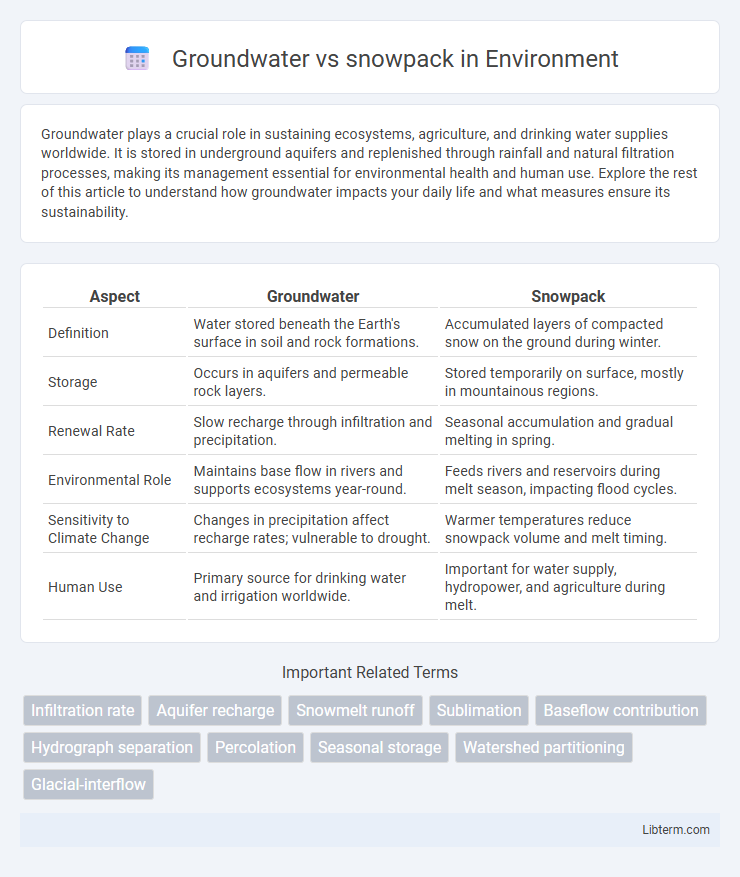Groundwater plays a crucial role in sustaining ecosystems, agriculture, and drinking water supplies worldwide. It is stored in underground aquifers and replenished through rainfall and natural filtration processes, making its management essential for environmental health and human use. Explore the rest of this article to understand how groundwater impacts your daily life and what measures ensure its sustainability.
Table of Comparison
| Aspect | Groundwater | Snowpack |
|---|---|---|
| Definition | Water stored beneath the Earth's surface in soil and rock formations. | Accumulated layers of compacted snow on the ground during winter. |
| Storage | Occurs in aquifers and permeable rock layers. | Stored temporarily on surface, mostly in mountainous regions. |
| Renewal Rate | Slow recharge through infiltration and precipitation. | Seasonal accumulation and gradual melting in spring. |
| Environmental Role | Maintains base flow in rivers and supports ecosystems year-round. | Feeds rivers and reservoirs during melt season, impacting flood cycles. |
| Sensitivity to Climate Change | Changes in precipitation affect recharge rates; vulnerable to drought. | Warmer temperatures reduce snowpack volume and melt timing. |
| Human Use | Primary source for drinking water and irrigation worldwide. | Important for water supply, hydropower, and agriculture during melt. |
Introduction to Groundwater and Snowpack
Groundwater, stored in aquifers beneath the Earth's surface, plays a crucial role in sustaining ecosystems and human water supplies. Snowpack accumulates seasonally in mountainous regions, acting as a natural reservoir that slowly releases meltwater to replenish rivers and groundwater systems. Understanding the interaction between groundwater and snowpack is essential for managing water resources and predicting hydrological responses to climate change.
Key Differences Between Groundwater and Snowpack
Groundwater is water stored beneath the Earth's surface in porous rock and soil, while snowpack refers to the accumulation of compressed snow on the ground during winter. Groundwater provides a stable, long-term water source that sustains ecosystems and human consumption, whereas snowpack acts as a seasonal water reservoir, releasing meltwater that replenishes rivers and groundwater supplies during warmer months. The key difference lies in their storage location and temporal dynamics, with groundwater being a relatively constant subsurface resource and snowpack a variable surface feature impacted by weather and climate conditions.
Formation and Sources of Groundwater
Groundwater forms primarily through the infiltration of precipitation, such as rain and melting snowpack, which percolates through soil and porous rock layers to accumulate in aquifers. Unlike snowpack, which is a temporary surface reservoir of frozen water, groundwater represents a subsurface, long-term water storage influenced by factors like soil permeability, geology, and climate conditions. Major sources contributing to groundwater recharge include rainfall, snowmelt from seasonal snowpack, and surface water bodies that seep into the ground, sustaining ecosystems and human water supplies.
Formation and Characteristics of Snowpack
Snowpack forms through the accumulation and compaction of snowfall over time, creating layered ice crystals with varying density and hardness influenced by temperature fluctuations and wind. This stratification impacts water retention, melt rate, and runoff during seasonal thaw, playing a critical role in regional hydrology. Unlike groundwater, which resides in subsurface aquifers, snowpack is a transient surface reservoir directly affected by atmospheric conditions and solar radiation.
Role in the Hydrological Cycle
Groundwater stores a significant portion of freshwater, gradually releasing it to streams and ecosystems, thereby sustaining baseflow during dry periods and regulating long-term water availability. Snowpack acts as a seasonal reservoir, accumulating precipitation during winter and releasing it as meltwater in warmer months, which replenishes surface water bodies and groundwater systems. Both components are critical in maintaining the balance of the hydrological cycle, influencing water storage, timing of runoff, and ecosystem health.
Seasonal Variations: Groundwater vs Snowpack
Seasonal variations between groundwater and snowpack are distinct, with snowpack accumulating in winter months and melting in spring, directly influencing surface water flow and replenishing groundwater reserves. Groundwater levels typically exhibit slower, more buffered changes, reflecting prolonged infiltration from snowmelt and precipitation over seasons. Understanding these temporal dynamics is crucial for water resource management, particularly in regions reliant on snowpack as a natural reservoir feeding groundwater systems.
Importance for Ecosystems and Agriculture
Groundwater provides a stable, year-round water source essential for sustaining ecosystems and agricultural productivity during dry periods. Snowpack acts as a natural reservoir, slowly releasing water through meltwater that replenishes rivers, streams, and groundwater reserves critical for crop irrigation and habitat maintenance. The balance between groundwater recharge and snowpack melt determines water availability, directly impacting biodiversity preservation and agricultural yields in many regions.
Impact of Climate Change on Groundwater and Snowpack
Climate change accelerates the melting of snowpack, reducing natural water storage that replenishes groundwater reserves. Rising temperatures lead to earlier snowmelt, causing reduced groundwater recharge and increased seasonal water scarcity. Changes in precipitation patterns further stress aquifers, threatening water availability for agriculture and ecosystems reliant on snowpack-fed groundwater.
Water Management Challenges and Solutions
Groundwater and snowpack serve as critical freshwater sources, each presenting unique water management challenges related to variability and storage. Groundwater depletion demands sustainable extraction practices, while snowpack's dependence on seasonal snowfall complicates water availability predictions. Integrated management approaches such as improved recharge techniques, enhanced snowpack monitoring, and adaptive policy frameworks optimize resource allocation and climate resilience.
Future Outlook: Sustainability of Water Resources
Groundwater and snowpack play critical roles in sustaining water resources, with climate change threatening their future reliability. Declining snowpack due to rising temperatures reduces natural water storage, increasing dependence on groundwater extraction, which may lead to depletion and reduced aquifer recharge. Sustainable management strategies must prioritize integrated monitoring, conservation, and adaptive policies to balance snowmelt variability and groundwater availability in the face of evolving hydrological cycles.
Groundwater Infographic

 libterm.com
libterm.com